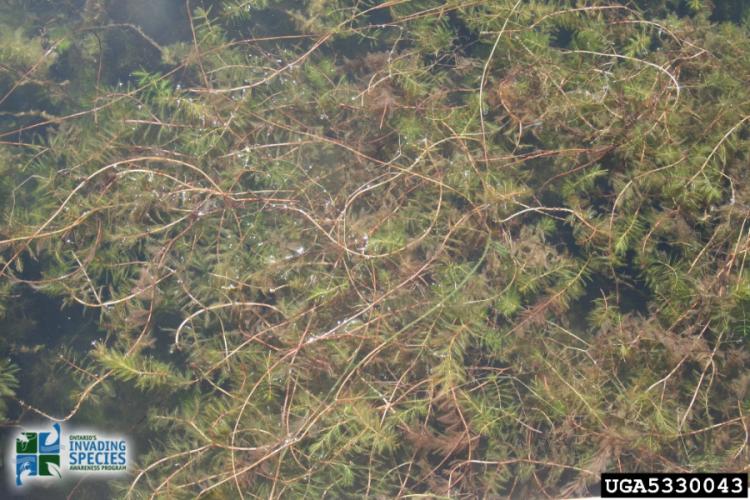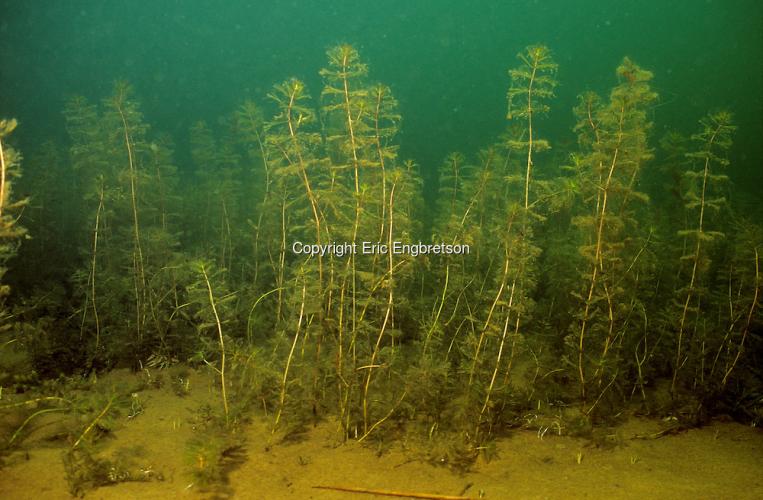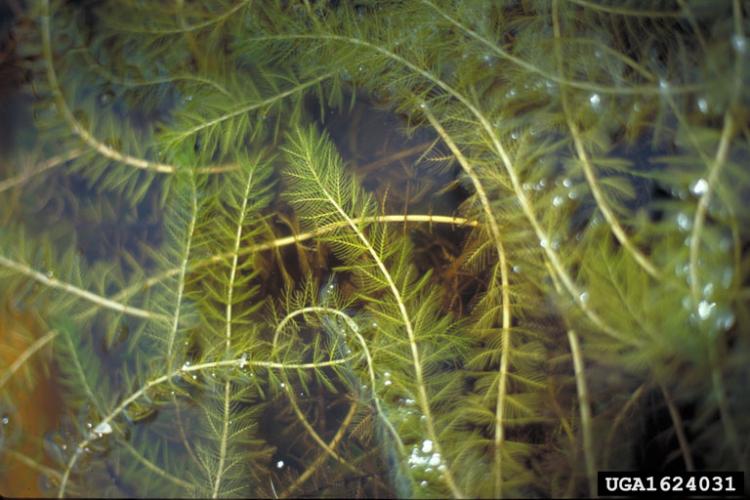Eurasian watermilfoil
Identification
Eurasian watermilfoil is a submersed perennial plant, with feather-like leaves grouped in 3-6 whorls around the stem. Unlike native milfoils, each leaf is divided into paired leaflets with 10-20 pairs per leaf (native milfoils typically have less). As stems approach the surface, the individual stems branch several times. Eurasian watermilfoil shoots and new growth often have a reddish color close to the surface. This plant will form small flowers in July and August, which occur just above the surface and are reddish or pinkish in color.
Biology
Origin
Eurasian watermilfoil is native to much of Europe, Asia, and northern Africa.
Habitat
Grows in a wide variety of lake and pond habitats, as well as low-energy areas of rivers and streams, from 1 to 10 meters in depth. The plant can grown to high densities under a range of temperature regimes, soil pH levels, and can tolerate brackish water. It has demonstrated extraordinary ability to flourish in systems with high disturbance from anthropogenic sources, including intense plant management, nutrient loading, or high motorboat traffic.
Ecological Threat
Eurasian water-milfoil competes aggressively to displace and reduce the diversity of native aquatic plants. It elongates from shoots initiated in the fall, beginning spring growth earlier than other aquatic plants. Tolerant of low water temperatures, it quickly grows to the surface, forming dense canopies that overtop and shade the surrounding vegetation. Canopy formation and light reduction, are significant factors in the decline of native plant abundance and diversity observed when Eurasian water-milfoil invades healthy plant communities.
Eurasian water-milfoil has less value as a food source for waterfowl than the native plants it replaces. And although fish may initially experience a favorable edge effect, the characteristics of Eurasian water-milfoil's overabundant growth negate any short-term benefits it may provide fish in healthy waters. At high densities, its foliage supports a lower abundance and diversity of invertebrates, organisms that serve as fish food. Dense cover allows high survival rates of young fish, however, larger predator fish lose foraging space and and are less efficient at obtaining their prey. Madsen et al. (1995) found growth and vigor of a warm-water fishery reduced by dense Eurasian water-milfoil cover.
The growth and senescence of thick vegetation degrades water quality and depletes dissolved oxygen levels. Typical dense beds restrict swimming, fishing and boating, clog water intakes and result in decaying mats that foul lakeside beaches.
Vermont Distribution
Eurasian watermilfoil is the most widespread aquatic invader in Vermont, with populations in over 80 waterbodies in the state. Check out the Vermont Department of Environmental Conservation's aquatic invasive species map (below) to view all waterbodies with a documented infestation.
C
How You Can Help
For most aquatic invasive species, humans are the primary vector of transport from one waterbody to another. Many of these nuisance plants and animals can be unknowingly carried on fishing gear, boating equipment, or in very small amounts of water in a watercraft. The easiest and most effective means to ensure that you are not moving aquatic invasives is to make sure that your vessel, as well as all your gear, is drained, clean, and dry.
BEFORE MOVING BOATS BETWEEN WATERBODIES:
-
CLEAN off any mud, plants, and animals from boat, trailer, motor and other equipment. Discard removed material in a trash receptacle or on high, dry ground where there is no danger of them washing into any water body.
-
DRAIN all water from boat, boat engine, and other equipment away from the water.
-
DRY anything that comes into contact with the water. Drying boat, trailer, and equipment in the sun for at least five days is recommended. If this is not possible, then rinse your boat, trailer parts, and other equipment with hot, high-pressure water.
Interested in monitoring for aquatic invasives?
- Join the VIPs! Vermont Invasive Patrollers help search for new infestations so we can respond immediately and prevent them from becoming established.
For more information, check out this video from the Vermont Fish and Wildlife Department.
Citations
Aiken, S.G., P.R. Newroth and I. Wile. 1979. The biology of Canadian weeds. 34. Myriophyllum spicatum L. Canadian Journal of Plant Science 59:201-215.
Engel, S. 1995. Eurasian watermilfoil as a fishery management tool. Fisheries 20(3):20-27.
Honnell, D., J.D. Madsen, and R.M. Smart. 1992. Effects of aquatic plants on water quality in pond ecosystems. Proceedings: 26th Annual Meeting, Aquatic Plant Control Research Program. Report A-92-2. U.S. Army Corps of Engineers Waterways Experiment Station, Vicksburg, MS.
Keast, A. 1984. The introduced aquatic macrophyte, Myriophyllum spicatum, as habitat for fish and their macroinvertebrate prey. Can. J. Zool. 62:1289-1303.
Lake Champlain Basin Aquatic Invasive Species Guide.
Lillie, R.A., and J. Budd. 1992. Habitat architecture of Myriophyllum spicatum L. as an index to habitat quality for fish and macroinvertebrates. Journal of Freshwater Ecology 7(2):113-125.
Madsen, J.D. 1994. Invasions and declines of submersed macrophytes in Lake George and other Adirondack lakes. Lake and Reservoir Management 10(1):19-23.
Madsen, J.D., J.W. Sutherland, J.A. Bloomfield, L.W. Eichler, and C.W. Boylen. 1991. The decline of native vegetation under dense Eurasian watermilfoil canopies. J. Aquatic Plant Management 29:94-99.
Patten, Jr., B.C. 1954. The status of some American species of Myriophyllum as revealed by the discovery of intergrade material between M. exalbescens Fern. and M. spicatum L. in New Jersey. Rhodora 56(670):213-225.
Smith, C.G., and J.W. Barko. 1990. Ecology of Eurasian watermilfoil. Journal of Aquatic Plant Management 28:55-64.
USGS Nonindigenous Aquatic Invasive Species, Eurasian Watermilfoil


